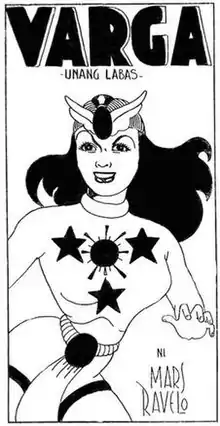Varga (comics)
Varga (real name: Narda) is a Filipino comic superheroine created by Marcial “Mars” Ravelo. Varga was the first female superhero in the Phillippines and was features in more numerous films, television shows and more than 500 comic books. The character first appeared in Bulaklak Magazine No.17, Vol.4 (July 23, 1947), but became famous under the name Darna in Filipino Komiks No.77 (May 13, 1950), where she was illustrated by Nestor Redondo.
| Varga | |
|---|---|
 Upon a shout and a touch, the violet-colored ghost Vara unites with the human child Olga, fused into one person in a single body: the superhero Varga (Vara + Olga). | |
| Publication information | |
| Publisher | Bulaklak Magazine |
| First appearance | 1947 |
| Created by | Mars Ravelo |
| In-story information | |
| Alter ego | Darna; Princess Vara; Olga |
| Species | Varan |
| Place of origin | Planet Vargon; Earth |
| Abilities |
|
Varga is an alien princess from the planet Vergon who crashed on Earth and decided to use her powers to fight crime and protect innocent people.Varga's powers derived from the Piedras Brillantes, a set of magical stones. her abilities includes the ability to fly and shooting energy beams from her eyes. She also have enhanced strength, speed, and agility.
In newer adaptations of the character she is a member of the Filipino justice league.
Publication history
Varga's character concept was created in 1939[1][2] years before she debuted in Bulaklak Magazine No.17, Vol.4 (July 23, 1947) which Ravelo wrote and drew himself.
The character Varga was archived twice, It was under the name "Darna" the character became famous.[3][4]In an interview, Ravelo revealed that he offered his creation first to Liwayway Magazine and then to other publications but was rejected several times.
The concept and image of Varga was based on illustrations of Superman from comic books brought by United States soldiers to the Philippines.[5]
The first concept image Ravelo had on Varga was a story about a mortal girl named Narda, her brother Ding and their grandmother Lola Asay. In this draft the characters lived in the town of Masambong when a falling star revealed itself to be a magic amulet and turned the little girl named Narda into the superhero Varga.
For more than six decades the character Varga wasn't published, until she was reboot character in the 2008 Komiks Presents: Varga TV series.
Costume
The original Varga's costume features long sleeved shirt with three stars that represents the Philippine flag, shorts and a simple belt with a loincloth (Bahag).
In the 2008 TV series, Varga wears a purple romper, cape and boots with gold details. Her outfit also includes some accessories like a golden headpiece with a "V" sign, and a golden medallion belt.
In other media
In Komiks Presents: Varga, a 2008 television series starring Mariel Rodriguez, Varga starred as an alien named Princess Varona from the planet Vargon. On Earth, Varga is assisted by a human girl named Olga in secretly protecting mankind and saving the world from “the forces of evil”.
Planet Vargon is the home to a race of powerful beings from outer space. Due to the destruction of her home planet, Vara escapes and landed on Earth, however, only existing in a ghost form. The Princess meets a young human girl name Olga, who is the only one who can see her, due to her kind heart. Under Olga's influence, Vara falls in love with the people of Earth.
These two women's destiny are meant to be merged literally. Upon a shout and a touch, the violet-colored ghost Vara unites with the human child Olga, fused into one person in a single body: the superhero Varga. Together, Vara and Olga begin their journey to become a real hero, and to defeat earth's enemy, Xandra - an evil woman who preys on the youth and beauty of others to stay young and beautiful.
Collected editions
| Title | Volume | Issue | Date |
|---|---|---|---|
| Varga | Bulaklak Magazine Vol. 4 | #1 | (1947–1948) |
| Bulaklak Magazine | #17 | July 23, 1947 | |
| Bulaklak Magazine p. 54 | #43 | May 12, 1948 | |
See also
References
- Darna: The Filipino Superheroine
- History marsravelodarna.net
- Mars Ravelo
- THE REAL STORY BEHIND CAPTAIN BARBELL
- Varga internationalhero.co.uk